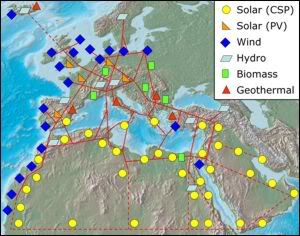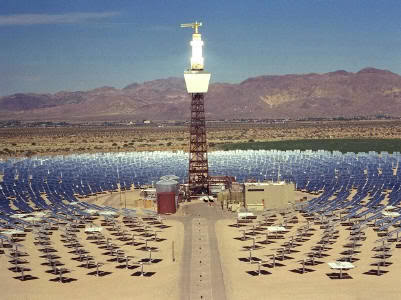As you might expect from an analyst who has written a series about the (renewable) electron economy, I believe that the mainstay of our future energy system will be electric generators powered by renewable energy. However, I hope to show here that this choice has a basis largely in economic, scientific, and technological reality rather than my personal prejudice or some of the social utopian ideals to which renewable energy has been attached.
Though I am for a comprehensive push to develop and deploy all types of renewable electric generators, constructing an economy where renewable energy does the heavy lifting will require a focus on specific strengths and weaknesses of renewable energy. Advocates for renewable energy have tended to either cluster into an “anything goes” ecumenical approach or focus on renewable energy as a self-generation option for households and business. Some have championed renewable energy as a means to even dismantle a widely interconnected grid, through each power user autonomously producing their own power. Why one would want to dismantle the grid seems to be a matter of personal preference or fixed ideas about how society should function rather than a reflection on the electric grid’s usefulness.

The approach to renewable energy I favor emphasizes the power of widely cross-linked generators to tap into the strengths of renewable energy and address its weaknesses in an energy economy where residential, commercial, and governmental users are actually depending on renewable electricity to provide them with the energy they need. Solar panels on rooftops or small windmills alone will not, with current generation and storage technology, be sufficient to substitute for the day-and-night, always-on power of our current grid. Combining large and small generators including solar thermal with storage, hydroelectric, pumped storage, biomass power plants, as well as more familiar wind and photovoltaic generators can reproduce, under most conditions, the reliable power of the grid.
The most promising technology in this area is not simply horizontally networked generators but a well-orchestrated mini-grid regulation system that can be called a “renewable combination power plant.” The renewable combination power plant joins discrete renewable generators together to deliver power exactly as it is needed by grid users, just as is done today with conventional power plants. In contrast, isolated renewable generators without storage produce power according to the availability of their primary renewable energy. The combination power plant operators respond to signals from the power grid operators about when and how much power is needed. A renewable combination power plant requires, as at least some components, clean storage technologies or dispatchable renewable resources like biomass power plants, hydroelectric, pumped storage, and solar thermal with storage. These controllable resources are then extended by wind, wave, tidal, geothermal or photovoltaic solar power, which produce power whenever they have incoming renewable energy.

Even with current technology, however, there is one renewable technology that can do a majority of the work of current fossil generators: solar thermal electric with thermal storage, also called CSP (concentrating solar power) with storage. Sited in desert or semi-arid areas, solar thermal electric uses mirrors to focus direct sunlight on a thermal fluid, like water, oil or molten salt that is used to make steam to generate electric or stored as heat in heat storage for later, similar use. The relative efficiency and low cost of thermal energy storage, the relative vastness of the world’s major deserts, and the consistency of the desert sun are the strengths of CSP with storage. Solar thermal with 16+ hours storage or solar baseload can substitute for coal generation during much of the year and about 1 percent of the area of the world’s deserts could generate all the power that the world currently uses.
The use of CSP to serve a majority of the world’s power customers requires the building of long distance power lines, most likely using high-voltage DC technology that can theoretically transmit power for 4,000 miles with about 20-25 percent losses. There are a number of concepts now being discussed, including DESERTEC, which links Europe with North Africa and the Middle East, as well as a concept I promote, the Solar Southwest Initiative, that foresees linking the Southwestern and Sonoran deserts with power demand centers across North America. In the end, local resources and distant renewable resources will combine to produce a complex but more robust and reliable clean power grid.
Added to the options of the combination power plant and solar thermal with storage are several other technologies that will significantly contribute to the renewable electron economy: small and medium hydroelectric, deep geothermal, as well as better publicized wind and solar photovoltaic. Developing these renewable power resources in some of the more favorable areas will involve the building of some new electric transmission, which advocates of small-scale renewable energy have often opposed (or opponents of transmission have often advocated small-scale renewables as if they substituted for large-scale renewables). The balancing of renewable energy flows across space and time to meet current demand for power requires transmission that links supply and demand.
Currently wind energy is one of the least expensive renewable energy sources and in the future solar photovoltaic (the flat panel technology seen on roofs and emergency call boxes) will probably be as inexpensive as wind. While both of these technologies are currently the “marquee” renewable technologies, alone they will not be able to shut down fossil power plants. Until electric energy storage is plentiful and cheap, these technologies will function best in the context of combination power plants
As described here, the renewable electron economy has the following advantages and disadvantages:
Pro:
- Carbon neutral or negative (in certain conditions) under operation.
- Primary energy (fuel) is free.
- Generators can be scaled from very small to very large; investment amounts can range from a few hundred dollars to several billion dollars.
- Primary energy is virtually endless.
- With the exception of biomass and certain geothermal wells, has no non-carbon emissions.
- Mature or rapidly maturing technologies in most categories of renewable generator.
- Deployable within a few months to a few years for most technologies (within critical period to reverse emissions trends).
- Dependent upon a diversity of primary energies.
Con:
- Many renewable energies are periodic or intermittent.
- Renewable energies occur naturally as energy flows rather than energy stores or stocks (with the exception of biomass); an all-renewable grid needs to build up and carefully manage stored energy.
- Overreliance on biomass, the primary natural energy storage medium, may tax soil and the biosphere.
- The reduction in solar energy around the winter solstice may present challenges for a solar-dominant all-renewable grid, especially during times of low wind.
- Catastrophic reductions of solar radiation (i.e. volcanic eruptions) can reduce the main energy in-flows; solar radiation is important to both solar and wind generators.
The renewable electron economy organized around combination renewable power plants and solar thermal power with thermal storage will minimize or eliminate most of the drawbacks of renewable energy. The emergence of scalable deep geothermal power or EGS, will address the latter two, more difficult but lower-frequency challenges facing an all-renewable grid.
Al Gore’s call: 100 percent renewables in 10 years
Al Gore has inspired many of us with his call for a 100 percent renewable grid to be built in 10 years, and in the area of energy policy we are in dire need of inspiration. On the other hand, considerations of reality, scientific and financial, need to work together with vision and inspiration to construct a functioning clean energy system in the real world. In my next installment, I will take a look at the policy and economic drivers for creating a renewable electron economy that will serve our energy needs and make the survival of a human-friendly biosphere more likely.

